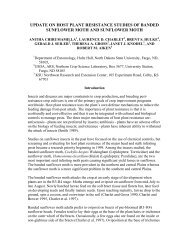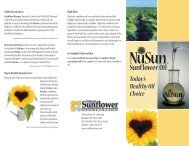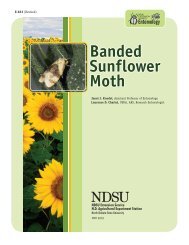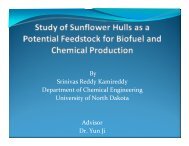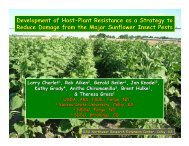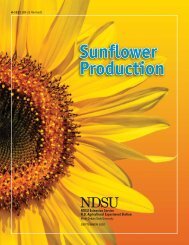Desiccation/Weeds - National Sunflower Association
Desiccation/Weeds - National Sunflower Association
Desiccation/Weeds - National Sunflower Association
- No tags were found...
Create successful ePaper yourself
Turn your PDF publications into a flip-book with our unique Google optimized e-Paper software.
Opportunities in<strong>Sunflower</strong> -<strong>Desiccation</strong>/<strong>Weeds</strong>Kirk Howatt - Rich ZollingerNDSU Weed Science
How much longer untilharvest?
•Natural desiccation can be slow and uneven•Poor weather can cause decline of yield and quality•Bird predation may cause substantial losses
http://www.naturalsciences.org/education/treks/swans_bears_06/images/Redwinged%2520Blackbird%2520flock.jpg&imgref
Photo provided by Dr. Burton Johnson, NDSU.
US Chemical <strong>Desiccation</strong>Options Prior to 2007• Defol (sodium chlorate)• Gramoxone Inteon (paraquat)similar to Reglone (diquat)
UntreatedRoundup
UntreatedGramoxoneRoundup
UntreatedSharpenGramoxoneRoundup
GramoxoneSharpen
UntreatedSharpenGramoxoneRoundup
Application Timing in US<strong>Sunflower</strong>• Labels state seed moisture under35%• Backside of heads yellow• Bracts turning brown• Dried disc flowers brush off easily
Staygreen trait causestiming uncertainty
Moisture Retentionin ReceptacleReceptacle MoistureOften DeterminesHarvest
<strong>Desiccation</strong>6 DATControlInteon or SharpenWeathermax
Days Earlier Harvest than Control in 2007DesiccantMinot, NDFargo, NDBrookings, SDHays, KS50%Paraquat371456Saflufenacil321226Glyphosate311483Glyt+saff35154640%Paraquat251105Saflufenacil277-15Glyphosate17903Glyt+saff26120530%Paraquat87-21Saflufenacil9602Glyphosate38-21Glyt+saff75-10
Days Earlier Harvest than Control in 2008DesiccantFargo, NDBrookings, SDHays, KS50%Paraquat1218Saflufenacil1014Glyphosate1117Glyt+saff51340%Paraquat610Saflufenacil715Glyphosate811Glyt+saff41330%Paraquat834Saflufenacil323Glyphosate633Glyt+saff610
Application Timing• Labels state seed moisture under35%• Backside of heads yellow• Bracts turning brown• Dried disc flowers brush off easily
How Much Brown on Bracts?Tip – 40-50% moistureNeck – 40%Shoulder – 30-35%
70% seed moisture
50% seed moisture
30% seed moisture
Thank you for yourkind attentionThe authors thank the <strong>National</strong> <strong>Sunflower</strong><strong>Association</strong> for support of this research.
#2 Oil Adjuvant RateVolume versus Area?
#2 Oil Adjuvant RateHow much oil adjuvant do youapply with your herbicides?
Adjuvant quizSome herbicide labels recommend oiladjuvants at % volume while others onan area basis (pt/A).Which method may not have sufficientadjuvant concentration in low gpa?A.% volumeB.Area
Oil adjuvant recommendationsHerbicide Oil 28% AMS-v/v- - v/v - /100 galRaptor (BASF) 1-2% 2.5% 12-15 lbAssure II (Dupont) 1% 2 qt/A 2 lb/AFirstRate (Dow) 1.2% 2.5% 8.5-17 lbValor (Valent) -- 1-2 qt/A 2-2.5 lb/AImpact (Amvac) 1-1.5% 1.25-2.5% 8.5-17 lbCallisto (Syngenta) 1% 2.5% 8.5 lb
Oil adjuvant recommendationsHerbicide Oil 28% AMS-v/v- - v/v - /100 galSelect (Arysta/Valent) 1% or 1qt 1-2 qt/A 2.5-4 lb/A>1 pt/ALaudis (Bayer) 1% but>1.25 pt/A 1.5 qt/A 1.5 lb/AStatus (BASF) 1-2 pt/A 1.25% 5-17 lbSharpen (BASF) 1% 1.25-2.5% 8.5-17 lb
2000 ND Pesticide Use SurveyWhat % of herbicide applicationsare made at < 10 gpa?
2000 ND Pesticide Use SurveyWhat % of applications are made= or < 10 gpa?88%What affect does this have onadjuvant rate?
Question:Should adjuvants be applied at % v/v or by area?Poast and Select = 1 qt/A of oil adjuvantAssure II, Fusidale DX, and Fusion = 1% v/v oilAt 17 gpa - 1% v/v PO = 0.17 gal =At 8.5 gpa - 1% v/v PO = 0.085 gal =
Question:Should adjuvants be applied at % v/v or by area?Poast and Select = 1 qt/A of oil adjuvantAssure II, Fusidale DX, and Fusion = 1% v/v oilAt 17 gpa - 1% v/v PO = 0.17 gal = 1.4 pt/AAt 8.5 gpa - 1% v/v PO = 0.085 gal = 0.68 pt/A
Gr. Foxtail control from nicosulfuron(Roehl)MSO+PO, pt/ASpray vol. 0.4 0.8(gpa) ------- % control -------8.5 64 (1%) 89 (2%)17 60 (0.5%) 84 (1%)LSD (5%) ------ 4 ------
Oat control from nicosulfuronMSOSpray vol. NIS 1% v/v 1.6 pt/A(gpa) -------------- % control --------------5 61 73 9610 67 73 9320 78 78 875 gpa = 8001 nozzle10 gpa = 8004 nozzle20 gpa = 8004 nozzle
Adjuvant practices:“Surfactants are used on a % basisbecause their function is spray retention.”“Oil is used on an area (pt/A) basisbecause they increase absorption.”“The assumption: Oils on an area basiswould function regardless of sprayvolume”
General rule:Apply oil adjuvants at 1% v/v butnot less than 1.25 pt/A.
#9 – DRT….ahh oh
Drift Reduction Technology (DRT)Open comment period ends March 5, 2010.
Example of DRT Language
Sprayer / Spray SolutionModificationsStar rating determines bufferdistance around each field!
Implementation of DRTPhenoxy herbicides targeted next!250 ft
100 ft
Buffer zonesQuestion – POST-DRTA 300 ft buffer zone is what % a ¼ sectionof land?300 ft¼ Section(160 A)½mile½ mileA. 10%B. 20%C. 30%D. 40%Shelterbelt
Droplet size:What will you do to your sprayer to getlarger droplets?
Weed control efficacy!
Label directions on droplet sizeHerbicide X label language:X
Some DRT conclusionsSomething has been forgotten in all thisDRT discombobulation –What is it?
Some DRT conclusionsSomething has been forgotten in all thisDRT discombobulation –What is it?Does droplet size affect weed control?
Lets put it all together now2 different principles1. Herbicide concentration in droplet(Pile Effect)2. Droplet size(Fines / Med / Crs / VC / Extrem Crse)
2009 North Dakota WeedControl ResearchGlyphosate with different spray volumes.Zollinger, Richard K., Jerry L. Ries, andAngela J. Kazmierczak.Brown section (Adjuvants) Page 6
Adjuvant Mode of Action #1BasketballsVolleyballs Pingpong balls
Lets put it all together now2. Droplet size(Fines / Med / Crs / VC / Extrem Crse)DRT says to use large droplets to minimizedrift……… does droplet size affectherbicide efficacy?
Poast response to nozzle sizeNDSU, NalewajaNozzleSprayerpassesNo.Vol.Grasscontrolgpa %8001 1 8.5 838001 2 17 818001 4 34 808002 1 17 708004 1 34 54
Accent (0.33 oz/A) efficacy by sprayvolume and adjuvantsNIS+Nozzle Volume AMSgpaMSOBasic Blnd1% 1.5 pt/A 1%gpa ------------ % grass control ------------8001 5 61 73 98 958004 10 67 73 96 978004 20 73 82 85 98LSD 0.05 ------------- 7 ----------------
Pursuit (2 fl oz/A) X nozzle size (15 mph)3 experiments (Nalewaja)NISNozzle Volume 0.25%gpa -----MSO1.5 pt/A----- % grass control -----8001 5 29 798002 10 25 572004 20 19 332006 30 15 22LSD 0.05 -------- 5 --------
Lets look at data6 Herbicides1. Glyphosate2. 2,4-D3. Poast4. Accent5. Pursuit6. Laudis7. Ignite
28 days after application ofphenoxy type herbicideVery coarse vs. Fine
2009 North Dakota WeedControl ResearchIgnite with droplet size.Zollinger, Richard K., Jerry L. Ries, andAngela J. Kazmierczak.Brown section (Adjuvant) Page 7-8
Some DRT conclusionsConsideration of university research –How apply field research if not use thesame droplet size and spray quality asapplicators?Point - Just adding herbicide formulationchanges the spray quality
Adjuvant Rule #1Not all adjuvants are created equal!
Glyphosate – Rest of the storyConclusions:1. All adjuvants are NOT created equal2. Adjuvant selection can be confusing3. Use adjuvants from reputable companies4. For glyphosate: No adjuvants have beenfound to optimize glyphosate more thanNIS + AMS
Adjuvant Rule #1Not all adjuvants are created equal!




